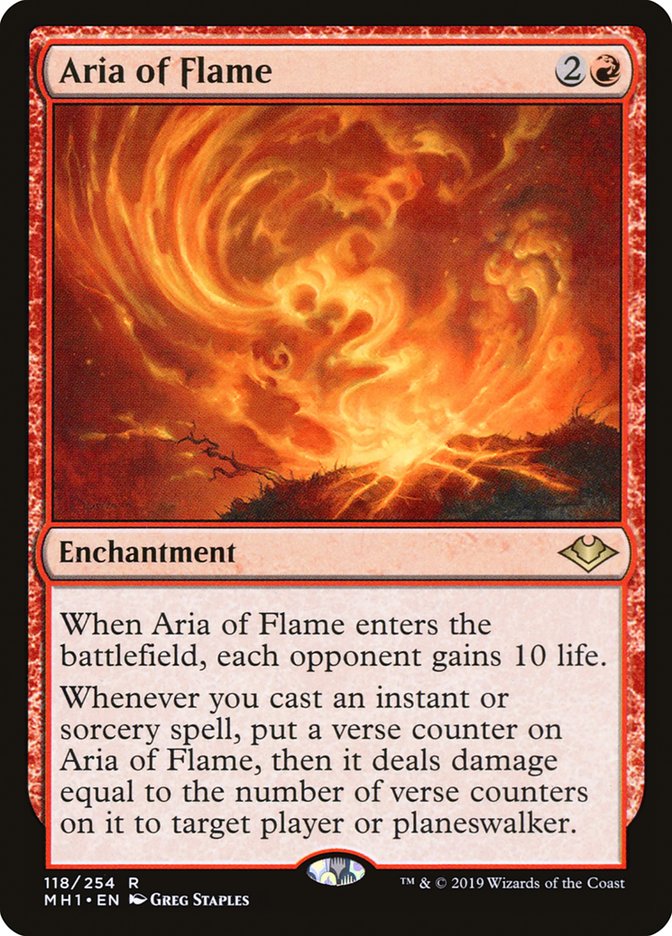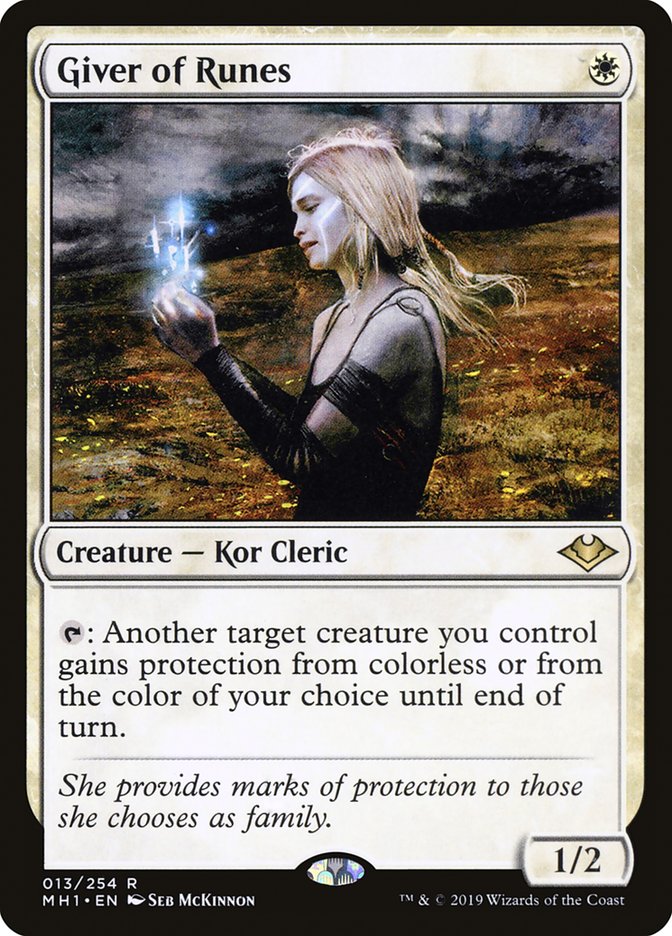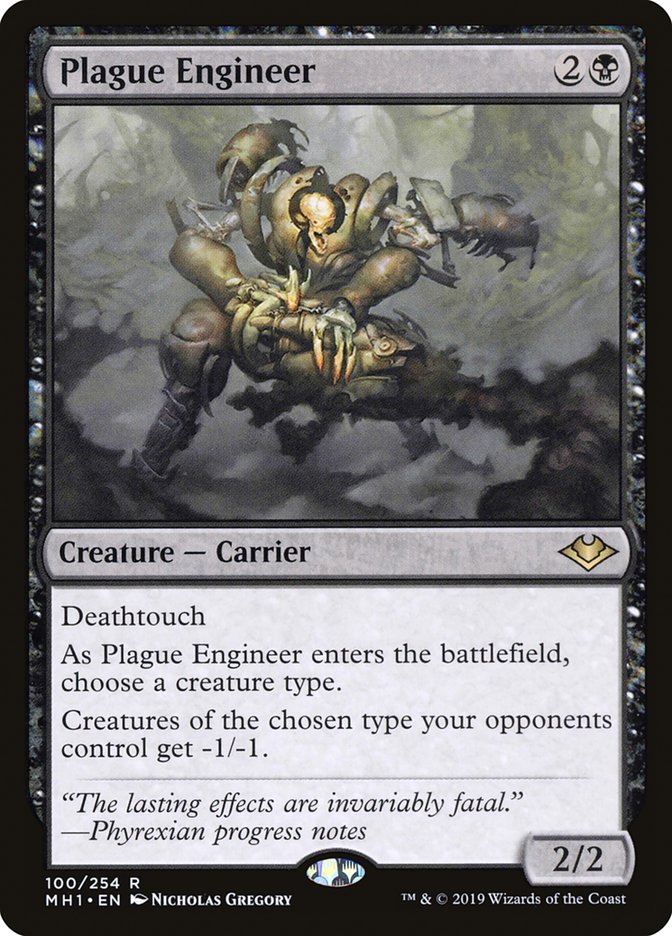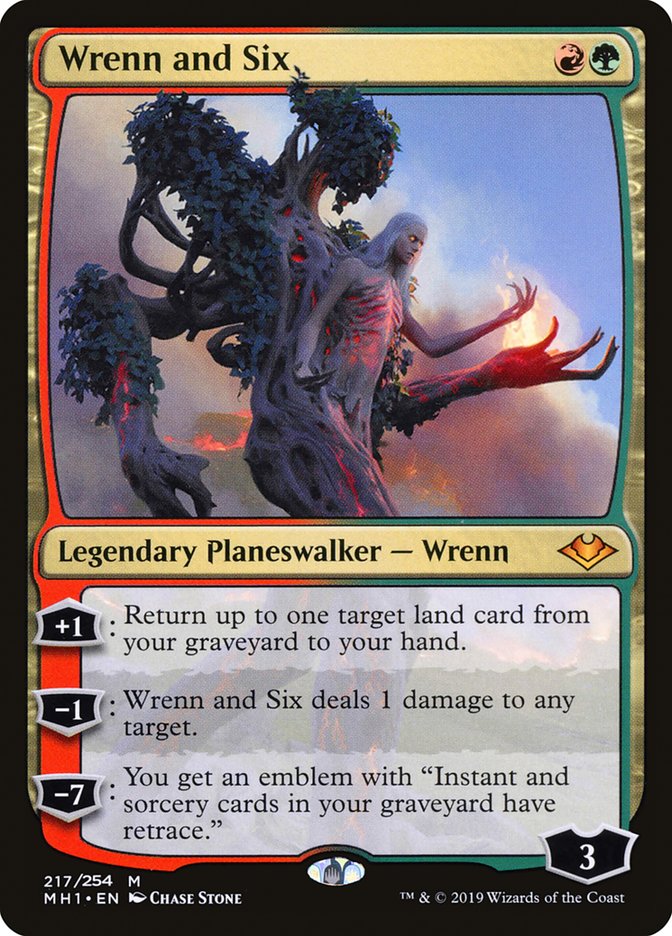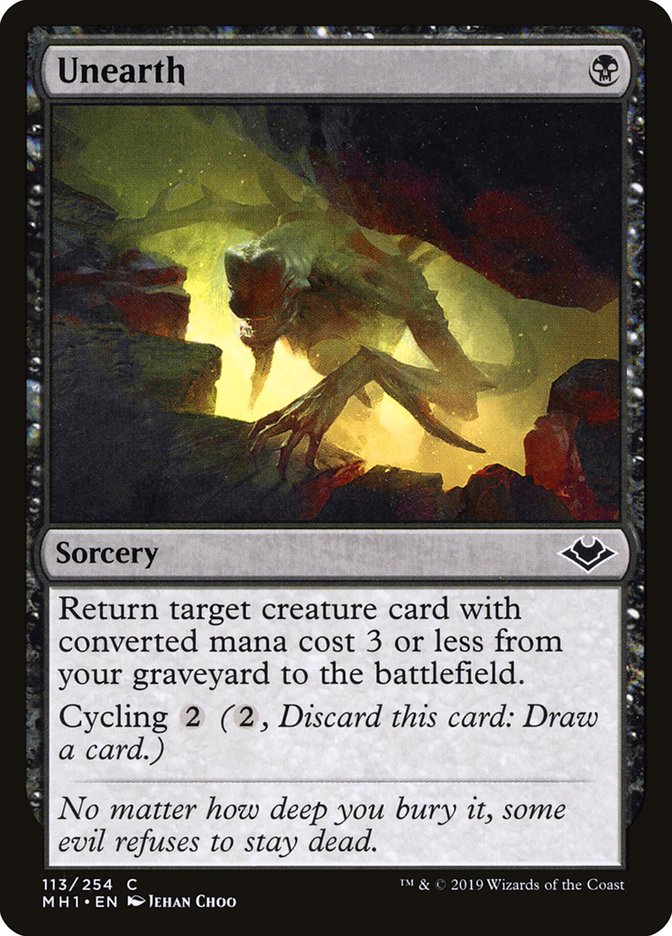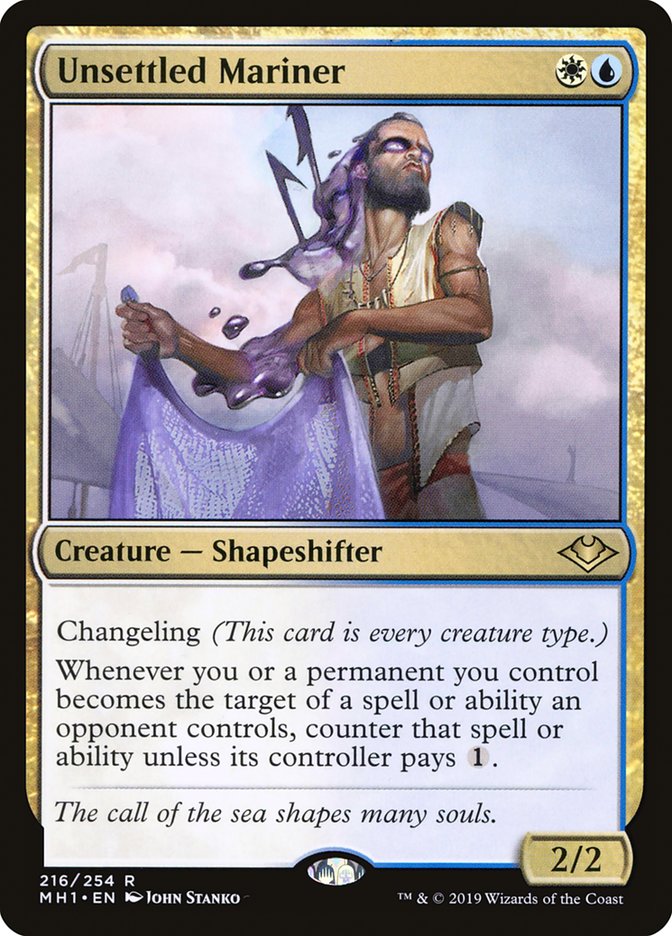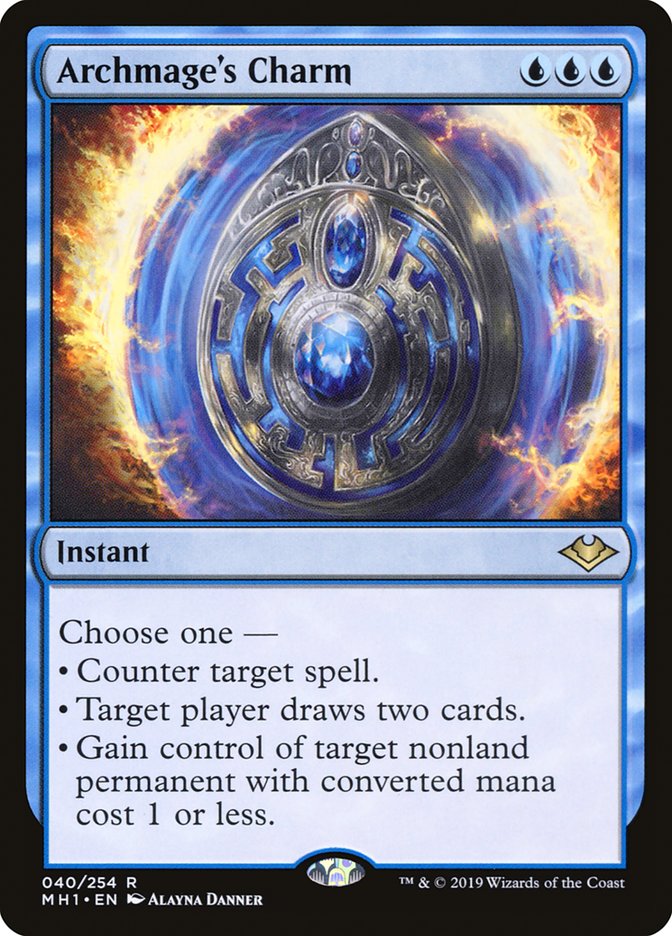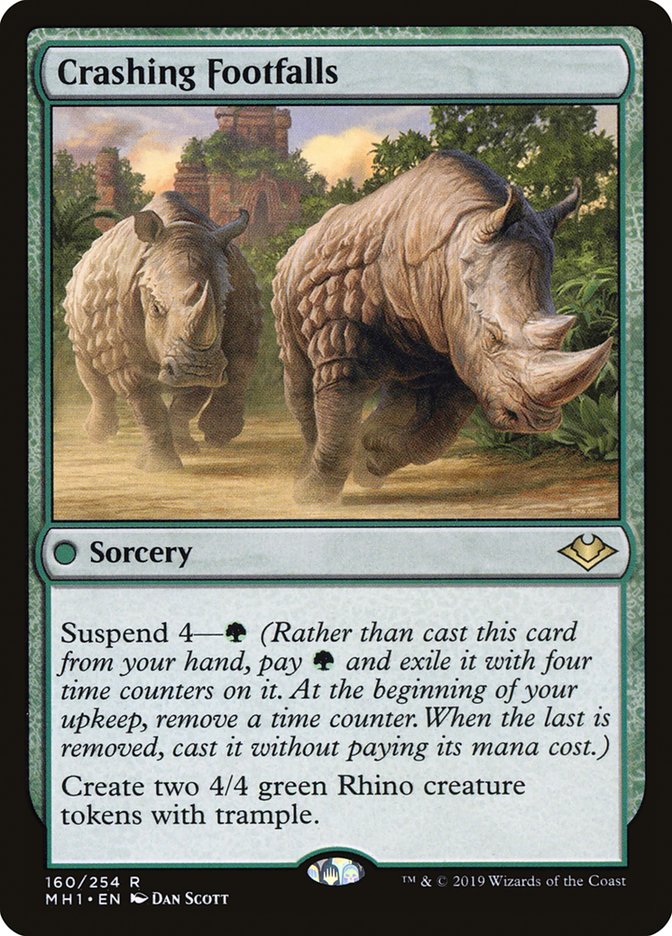I’ve been around for a lot of significant Banned and Restricted announcements, from Skullclamp and the too-late dismantling of Affinity in Standard, to Mental Misstep in Legacy, to Splinter Twin and Birthing Pod in Modern. Recently, in the run-up to anticipated announcements, I’ve been asked what I’ll do if the deck I’m currently playing gets the axe and if I’ll be upset to lose my deck du jour.
For the most part I’m not attached to any given deck. Through rotations or bans or metagame shifts, the decks we play and love all go away eventually, and it’s my job to move on and find the next piece of technology, the next hot deck.
But I’d be lying if I said I wasn’t rooting for Faithless Looting to emerge unscathed from yesterday’s announcement. Izzet Phoenix has been among the most fun decks I’ve ever played, and certainly tops the list among decks with which I’ve had significant tournament success. It’s also the deck I’m most associated with, supplanting Legacy Elves and Modern Dredge. It seems like every weekend I’m signing another set of Arclight Phoenixes, so seeing the deck go with a ban of Faithless Looting would’ve been hard.
Fortunately, the firebirds will once again live to see another day:
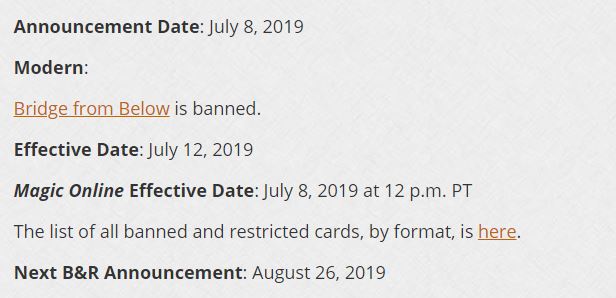
Bridge from Below is a sensible ban, since it significantly limits the most degenerate draws from Bridgevine, in particular taking away the potential for combo kills with Hogaak, Arisen Necropolis and Altar of Dementia. It does leave the Vengevine portion of the deck intact so it’s possible the deck is still a player, but it’ll have to prove to be more consistent than Dredge, which is a tough ask.
More importantly, it leaves Izzet Phoenix completely intact, so I can keep not worrying much about Modern, especially now that Aria of Flame has supplanted the carousel of mediocre options that inhabited the last threat slots.
However, Bridgevine was so powerful it seemed to completely warp the metagame around it. Decks like Humans and Azorius Control stuck around, but in diminished numbers, while big mana decks like Mono-Green Tron and Amulet Titan all but disappeared.
On a macro level, Bridgevine made many traditional axes of interaction, removal and counterspells in particular, quite poor, and instead skewed everyone toward graveyard hate and powerful, proactive strategies that could close the game before the Bridgevine deck could recover from the hate.
In the wake of the Bridge from Below ban, Modern should return to its more interactive self, no matter what scores of Twitter faces might tell you. That change is going to open up a lot of space for some of the many sweet Modern Horizons cards to take a significant role in the metagame. We already saw Aria of Flame elevate Izzet Phoenix, and the combination of Goblin Engineer and Urza, Lord High Artificer elevate the Thopter-Sword engine to competitive viability, but there’s plenty more that this set has to offer, so here are some cards I’d look to in the coming weeks as the post-ban Modern metagame takes shape:
Giver of Runes
Giver of Runes received some early hype when used as a proactive protection spell for Devoted Druid, but the way the metagame shaped up, that protection wasn’t as relevant and the deck wasn’t consistent enough to carry it into the top tier. In a slower metagame, that lack of consistency isn’t as exploitable, while the ability to draw out removal is more relevant than it was before, so I wouldn’t be too quick to dismiss a similar deck just because it didn’t work out the first time.
But more than that, Giver of Runes can slot into plenty of decks. I wrote about a few of those decks when the card was first previewed, and each of them gains a lot from drawing out those early Lightning Bolts and Fatal Pushes.
Whenever you can force your opponent’s hand with how or when they use their interaction, you significantly limit their ability to sequence their own spells optimally. Mother of Runes being able to target itself draws out removal immediately, but Giver of Runes drawing removal away from key two-drops isn’t far behind in terms of how much it mucks up opposing lines of play. As the format moves to something more interactive, getting that kind of impact on Turn 1 is much better.
Plague Engineer
We saw Plague Engineer pop up in the Bridgevine metagame, typically naming Zombie to stop Bloodghast and Gravecrawler, but its function there was as part of a larger package because stopping Bridge from Below was critical; otherwise, Plague Engineer would simply facilitate the creation of an army of 1/1 Zombie tokens.
Moving forward, the card will have a much larger pool of decks to target, and it will demonstrate that it’s more than a mediocre piece of graveyard hate. It’s an incredibly powerful option against most aggro decks in Modern, since they tend to rely on tribal synergies to compete with everything else that goes on in the format.
The obvious applications are against Humans and Spirits, where taking out Noble Hierarch; Thalia, Guardian of Thraben; Rattlechains; etc. gives the card an immediate impact, while the 2/2 deathtouch body can rumble in combat to handle an oversized Champion of the Parish.
The ability to take out Thalia without giving anything up to the tax is incredibly valuable for a deck like Jund that often gets tempoed out by the disruptive elements in the Humans deck, while their discard is unable to punch a hole in a curve that is so condensed between one and three.
Creatures (16)
Planeswalkers (3)
Lands (24)
Spells (17)

I’d also look to apply Plague Engineer against decks that rely on 1/1s, even if the deck isn’t tribal. Plague Engineer stops the tokens from Thopter Foundry or Lingering Souls in midrange mirrors, and can kill Blighted Agent and Noble Hierarch against Infect and then trade for a Glistener Elf.
The wide range of applications for Plague Engineer without sacrificing power makes it an excellent sideboard card that can sneak into maindecks in certain metagames, so I expect to see a lot of it moving forward.
Wrenn and Six
Another card that helps those who just couldn’t put down Jund, Wrenn and Six, like Plague Engineer offers another efficient answer to Thalia, Guardian of Thraben, since often you can land the planeswalker before Thalia even enters the battlefield, and ensuring you can hit your land drops makes it easy to not fall behind to an early stumble.
In addition to its applications against aggressive decks, Wrenn and Six combines with Ghost Quarter and Field of Ruin to disrupt Tron, a historically bad matchup. It’s not often you have a card that helps against such a disparate spread of matchups, and so it goes a long way towards mitigating the issue of midrange decks drawing the wrong disruption for the wrong matchup.
With a few other utility lands, like Nurturing Peatland, cycling lands, and Raging Ravine, you even have a card that provides significant card advantage in attrition-oriented matchups. I would caution against going overboard with a Wrenn and Six toolbox, but find the appropriate balance and you have one of the most powerful threats for a midrange decks since Tireless Tracker.
Unearth
Black is my least favorite color in Magic, but Unearth is one of my favorite cards, so much so that, by itself, it can motivate me to put some Swamps in my deck. And in a large format like Modern, there are many creatures it combines well with, from Monastery Mentor to Seasoned Pyromancer to Snapcaster Mage to Tireless Tracker, just to name a few.
Unearth can fit nicely into a Mardu Pyromancer, Esper Mentor, or Grixis Death’s Shadow shell. They all play a small number of powerful threats that gain card advantage paired with powerful disruption and card selection.
With a low curve, these decks can play a correspondingly low land count to mitigate flood and offer virtual card advantage when the game goes long, but they can be exploited by removal-heavy strategies because of their nominally low threat density. Unearth functioning as both a threat and spell is the perfect countermeasure, and targeting Seasoned Pyromancer and Monastery Mentor can lead to some incredible turns.
Unsettled Mariner
I’ve been high on this card for a while in Humans and Spirits alike, but like Giver of Runes, it wasn’t appropriate in such a fast format that was low on interaction. With more removal around, this card doesn’t replace Thalia, Guardian of Thraben. It supplements Thalia, offering aggressive decks even more ways to disrupt opposing removal in the early-game so they can establish an advantage on the battlefield.
The major issue here is that it’s another relatively small body without evasion, but with Deputy of Detention offering these decks more removal in addition to their many Anthem effects, I don’t see that as much of a problem. Few decks can keep up with the tribal aggro decks just by putting blockers in the way, so focusing your disruption on stopping spot removal makes a lot of sense.
Of course, Unsettled Mariner has plenty of other applications, from hosing Burn to taxing the Ad Nauseam combo and cards like Gifts Ungiven. And with the ability formatted as a trigger, I’m sure you’ll get a few free counterspells out of the card.
Archmage’s Charm
When everyone was first exploring Modern Horizons and the menace of Bridgevine had yet to take over the metagame, I saw a few Izzet Delver lists putting up results online. The archetype has been tried many times in Modern over the years but hasn’t been able to replicate the success it’s had in Legacy without a powerful suite of spells backing up the cheap threats. Force of Negation is the obvious addition here, but Archmage’s Charm is the unsung hero of the deck. Three mana is a lot in Modern, but the card provides more than enough for its cost.
It’s a powerful removal spell against Champion of the Parish and Death’s Shadow, cards which can quickly blank Lightning Bolt; a quick burst of card advantage in attrition matchups; and a clean counterspell against big mana and combo decks. Modern as a format stresses mana efficiency, but with the wide array of threats in Modern, filling out your spell suite with a slightly more expensive but much more flexible card can be very helpful, and that’s the case with Archmage’s Charm.
Archmage’s Charm is the most powerful card of this type since Kolaghan’s Command, and with Prismatic Vista offering another fetchland to provide easy mana fixing for Island-heavy manabases that can also find basic Mountain in matchups where your life total is heavily taxed, I don’t see the prohibitive mana cost keeping this one from seeing consistent play. And if it helps to bring Delver decks into Modern for the first time since 2012, that’s even better.
Crashing Footfalls
We’ve seen a lot of As Foretold decks in Modern since the card’s printing, most of them setting up devastating combos with cards like Living End and Restore Balance. But those combo decks were rather slow and as such were relegated to the fringe of the metagame. Ancestral Vision could give the decks some staying power, but when you’re building around assembling specific cards, it’s best for the result to be something that has significant impact on the battlefield.
Crashing Footfalls definitely does that. A pair of 4/4s on Turn 3 (or Turn 2 with Electrodominance) is a significant clock that will usually soak up two removal spells so you’re not losing any card advantage. Those 4/4s can also play defense against aggressive decks, buying you time to set up more impactful plays later on.
The card also plays nicely with Dreadhorde Arcanist, opening up another angle to cast suspend cards without waiting and adding another layer of consistency to a deck that is trying to set up a series of two-card combos.
Creatures (8)
Lands (17)
Spells (35)
- 2 Lightning Bolt
- 2 Mountain
- 4 Ancestral Vision
- 2 Lightning Axe
- 3 Thoughtseize
- 4 Inquisition of Kozilek
- 4 Faithless Looting
- 2 Collective Brutality
- 2 Fatal Push
- 4 Electrodominance
- 2 Finale of Promise
- 4 Crashing Footfalls
Sideboard

I’m concerned about decks like these having enough space for disruption to cover the entire Modern metagame, but Crashing Footfalls is a great payoff for the shell, and it’s not like it’s ever been difficult to make Izzet shells work in Modern.
Things Are Back To Normal
Bridgevine unfortunately took a lot of the hype away from Modern Horizons by unleashing the most dominant deck the format has seen since Eldrazi Winter, but with that deck effectively neutralized, it’s time to get back to normalcy. And that means exploring everything this set has to offer, which is a lot.
Even though I’ll certainly be jamming Arclight Phoenix, I’m excited to see how everything shapes out. This is among the most exciting times in memory to be playing Modern, and with several Opens featuring the format as well as Mythic Championship IV coming up later this month, the metagame is going to solidify rather quickly.



